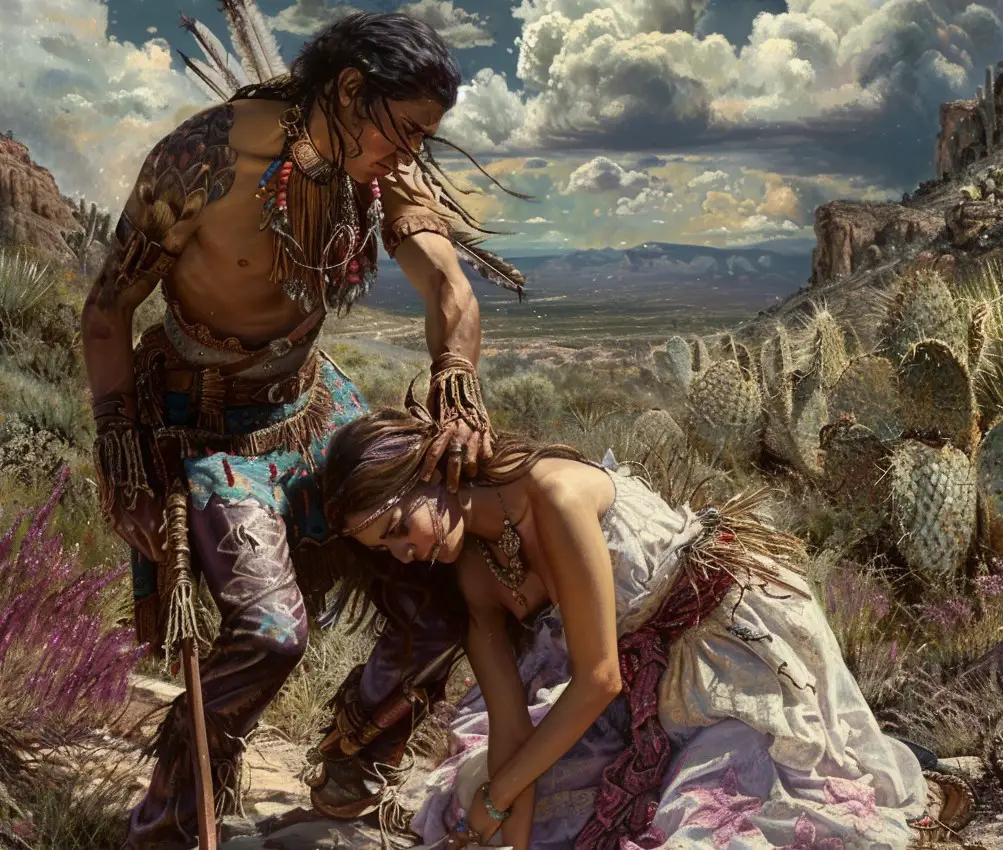Podcast: Play in new window | Download
Subscribe: Apple Podcasts | RSS
 Nestled along the rugged coastline of northwestern Mexico, the Seri people inhabit a land of stark beauty and cultural richness. The Seris call themselves the Comca’ac and the name “Seri” is believed to be a name given to this group by the neighboring Yaqui people. “Seri” may mean “people of the desert,” in an extinct Yaqui dialect, but this is not certain. Some researchers also believe that the name comes from the language of Opata people who lived northeast of Seri territory. What is known for sure is that the Seris are not related to any other neighboring indigenous groups. As one of the few remaining native peoples of the Sonoran Desert, the Seri have preserved their unique way of life amidst the arid landscapes and shimmering seas. With a deep connection to their ancestral lands and a rich oral tradition passed down through generations, the Seri offer a glimpse into a world shaped by resilience, harmony with nature, and the enduring spirit of their people. Here are three legends from the Seri.
Nestled along the rugged coastline of northwestern Mexico, the Seri people inhabit a land of stark beauty and cultural richness. The Seris call themselves the Comca’ac and the name “Seri” is believed to be a name given to this group by the neighboring Yaqui people. “Seri” may mean “people of the desert,” in an extinct Yaqui dialect, but this is not certain. Some researchers also believe that the name comes from the language of Opata people who lived northeast of Seri territory. What is known for sure is that the Seris are not related to any other neighboring indigenous groups. As one of the few remaining native peoples of the Sonoran Desert, the Seri have preserved their unique way of life amidst the arid landscapes and shimmering seas. With a deep connection to their ancestral lands and a rich oral tradition passed down through generations, the Seri offer a glimpse into a world shaped by resilience, harmony with nature, and the enduring spirit of their people. Here are three legends from the Seri.
- The Time of Giants
A long time ago, the Seris were not like they are today, rather, they were giants that inhabited the desert and were living leisurely lives wanting for nothing. The god of these giants decided to put them to the test and told them that they would have to hunt for their food to survive. The giants didn’t know how to hunt, but they found it very easy to catch fish. Their skills allowed them to control the bounty of the sea, so they established themselves near the shore. The place where they lived was flat land, with no hills, so the land was frequently flooded. The Seri god decided to form the mountains to protect people from the water. One day there was a great flood and the giants fled to the mountains, but the water reached them. All the giants drowned and were transformed into huge desert plants known as cirios, which stand 8 to 10 feet tall and are known in English as boojum trees. The god of the giants then created smaller people to live on the land and these towering cirio plants still house the spirits of the giants that protect the territory of the Seri. The tall desert sentinels are said to become animate and punish anyone who does not respect life and the spirits inhabiting the Seri lands.
- The Love Story of Lola and Coyote Iguana
This legend is more contemporary and takes place in the early 1800s. Roads going through the remote parts of Sonora during this time were dangerous for the caravans of carts that traveled between the towns, all scattered through the territories of the different tribes who still lived in resistance to conquest by outsiders. Among the most feared names of the time was Coyote Iguana, who commanded the Seri legions with lethal effectiveness in combat against the Spanish. Rumors said that he could transform at will into either of the two animals to escape the enemy or take the form of an unstoppable warrior thanks to the help of the spirits, who guided him in repelling the attacks of the European invaders. Even so, what went down in history about Coyote Iguana was not his bow and arrow, but the day his heart betrayed him, when destiny brought him together with that woman who left by carriage from the coastal town of Guaymas.
Dolores Casanova was barely 18 years old, the daughter of a Spanish father and Mexican mother. Some say that she was of such enviable beauty that she had been named queen of the Carnival of Guaymas not long before. Although she was not from the nobility, the young Dolores Casanova had never lacked for anything. Her many suitors and strangers alike would shower her with gifts and attention, and thus she lived the life of a European royal. Her life would abruptly change when she and her relatives decided to travel by overland coach to the city of Hermosillo. There was little she could have done from the carriage when, upon arriving at a stop called La Palmita, the fears of all the travelers came true: An arrow broke the air and stuck in the head of one of the carriages. The Seris started their attack. At times it seemed that the caravan would manage to repel the attack, but Coyote Iguana and his men were relentless, and they finished off everyone; everyone except Lola Casanova.
 When Lola opened her eyes after the attack, she found herself being carried by a tall man, with sunburned copper skin and such strength that she seemed to float through the air in his arms. He barely spoke Spanish, but enough to, in that moment of terror, promise her all the treasures of the earth. He was Coyote Iguana, the war leader of the Seri people, the most powerful and feared man in the world for them. When he was little, the tribe captured him after killing his father in combat, but they soon took an appreciation and respect for his war skills. And now he was in love with this beautiful female captive. Coyote Iguana promised Lola all the wealth of his nation so that she would stay with him, even though she was undoubtedly a prisoner of the Seri. From one moment to the next, the illusions of a life with her own people – a grand wedding with a man she loved, her family, her hometown, an elegant future – completely disappeared and she soon became the imprisoned queen of a kingdom she did not know.
When Lola opened her eyes after the attack, she found herself being carried by a tall man, with sunburned copper skin and such strength that she seemed to float through the air in his arms. He barely spoke Spanish, but enough to, in that moment of terror, promise her all the treasures of the earth. He was Coyote Iguana, the war leader of the Seri people, the most powerful and feared man in the world for them. When he was little, the tribe captured him after killing his father in combat, but they soon took an appreciation and respect for his war skills. And now he was in love with this beautiful female captive. Coyote Iguana promised Lola all the wealth of his nation so that she would stay with him, even though she was undoubtedly a prisoner of the Seri. From one moment to the next, the illusions of a life with her own people – a grand wedding with a man she loved, her family, her hometown, an elegant future – completely disappeared and she soon became the imprisoned queen of a kingdom she did not know.
Little by little Lola learned the lifestyle of the Seris, to paint her face in the traditional way, to live from nature. It is even said that she eventually fell in love with Coyote Iguana, whom she had at the same time feared and respected. Although the Seri women rejected Lola at first, they learned to live with her and respect her place alongside the chief of the tribe, and she reciprocated her place by giving Coyote Iguana an heir, who promised to be the first of a great desert dynasty.
The birth of Coyote Iguana II was Lola’s final break with her past life. She had found her unconditional love for her new family too great to return to her old life even when the opportunity presented itself. When she was finally able to visit Hermosillo, she found that her own family no longer recognized her, and society looked at her with contempt rather than compassion. She soon returned to the desolate land where she was queen, strange and hated by many, but a queen in the end.
Years passed, and even great warriors end up wearing out. Coyote Iguana died due to the contempt of his tribe, who threw his body to the dogs to be torn apart, and Lola was displaced along with her children. But Coyote Iguana II was growing up and becoming wiser and stronger. Upon becoming a man, he managed to regain command and led the tribe for many years in the company of his mother. The youngest of the brothers, aptly named Coyote Iguana III, was equally brave or braver than his brother in the leadership of the tribe and took care of Lola Casanova until the end of her days, in which she was seen sitting in front of her house by the sea contemplating the sunset, remembering another beach, that of her native Guaymas, and what could have been.
- The Legend of the Starfish
Long ago a chief of the Seri named Haas had a daughter named Kapsis. The little girl grew up with all possible care and as time went by, she began to acquire more responsibilities. One day, after finishing her work, she approached the sea, huddled next to a rock and watched the waves come and go. She crouched there for hours, motionless and silent, looking up at the sky and across the waters. The tribe followed her with their eyes full of surprise, every day they saw the same routine until the shadows became blacker on the water and on the beach. The young woman looked across the vastness of the seascape hoping the goddess Xtamosbin, the great sea turtle, would arrive from the bottom. Every time her people arrived from Kino Bay to Shark Island, Kapsis would run to her favorite place on the beach to contemplate the sky and sea.
Chief Hasss asked the hacocama, a Seri medicine man, to destroy the spell that had surely taken hold of his daughter. It was the explanation that her father found, because the beautiful young woman fled from the company of her peers and she did not dance or sing. This assignment had turned out to be useless. Kapsis only enjoyed refuge on the desolate beach, seeking solace in a sad landscape even in times fearsome storms. The thing is, no one knew Kapsis’s secret. She was in love with the stars in the sky which she considered to be the flowers of the gods.
 The tribe claimed that Kapsis was the victim of bad magic and that her spirit had been switched with that of a shark, so the hacocama, or medicine man, went to a special cave located high up on the mountain. There he prepared himself to try to return Kapsis to normal. In the light of a full moon, the medicine man left the mountain cave and went to the young woman’s side. He placed his hands on Kapsis’ forehead, uttering ancient spells and singing sacred songs. Kapsis backed off nonchalantly and quietly walked away from him, as if nothing was happening and nothing was wrong, even though the hacocama wasn’t finished with his ceremony.
The tribe claimed that Kapsis was the victim of bad magic and that her spirit had been switched with that of a shark, so the hacocama, or medicine man, went to a special cave located high up on the mountain. There he prepared himself to try to return Kapsis to normal. In the light of a full moon, the medicine man left the mountain cave and went to the young woman’s side. He placed his hands on Kapsis’ forehead, uttering ancient spells and singing sacred songs. Kapsis backed off nonchalantly and quietly walked away from him, as if nothing was happening and nothing was wrong, even though the hacocama wasn’t finished with his ceremony.
Kapsis did what she normally did and walked to the sea. She wanted nothing of her tribe’s rituals and didn’t care what others thought of her. She felt great comfort just gazing at the sky. After a few hours in her happy place, Kapsis saw a shooting star cross the great expanse of the night and fall into the water. She got into a canoe and rowed to the place where the star had plunged into the sea. She looked around and then threw herself into the water to try to find it. In her rapid descent, Kapsis’ head hit the rocky bottom, knocking her unconscious a few feet below the water. On a bed of treacherous rocks, Kapsis lay motionless. With her arms open in a cross and her beautiful legs extended, she had died.
Xtamosbin, the sacred sea turtle, goddess of the Seris, found Kapsis pale and lifeless at the bottom of the sea. The goddess was moved by the young woman’s desire to save a drowning star. So, with her hands on the inert body of the young Kapsis, the powerful sea goddess turned the young woman into a beautiful starfish. From that moment Kapsis would be happy. In that silent aquatic world without nosy people, she would contemplate the vastness of the sea, and from the shallow waters she would look up to the starry sky she loved so much.
For a general overview of the Seri people, please see Mexico Unexplained episode 209: https://mexicounexplained.com/seri-people-the-last-to-assimilate/
REFERENCES
Coolidge, Dane and Mary Coolidge. The Last of the Seris. Glorieta, NM: Rio Grande Press, 1971. We are Amazon affiliates, buy the book on Amazon here: https://amzn.to/49MdpDF
